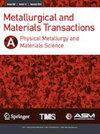Quasi-In Situ Localized Corrosion of an Additively Manufactured FeCo Alloy in 5 Wt Pct NaCl Solution
IF 2.5
3区 材料科学
Q3 MATERIALS SCIENCE, MULTIDISCIPLINARY
Metallurgical and Materials Transactions A-Physical Metallurgy and Materials Science
Pub Date : 2023-09-10
DOI:10.1007/s11661-023-07186-7
引用次数: 0
Abstract
Abstract FeCo alloys are important materials used in pumps and motors in the offshore oil and gas drilling industry. These alloys are subjected to marine environments with a high NaCl concentration, therefore, corrosion and catastrophic failure are anticipated. So, the surface dissolution of additively manufactured FeCo samples is investigated in a quasi- in situ manner, in particular, the pitting corrosion in 5.0 wt pct NaCl solution. The local dissolution of the same sample region is monitored after 24, 72, and 168 hours. Here, the formation of rectangular and circular pits of ultra-fine dimensions (less than 0.5 µ m) is observed with increasing immersion time. In addition, the formation of a corrosion-inhibiting surface layer is detected on the sample surface. Surface dissolution leads to a change in the surface structure, however, no change in grain shape or grain size is noticed. The surface topography after local dissolution is correlated to the grain orientation. Quasi- in situ analysis shows the preferential dissolution of high-angle grain boundaries (HAGBs) leading to a change in the fraction of HAGBs and low-angle grain boundaries fraction (LAGBs). For the FeCo sample, a potentiodynamic polarisation test reveals a corrosion potential (E corr ) of − 0.475 V referred to the standard hydrogen electrode (SHE) and a corrosion exchange current density (i corr ) of 0.0848 A/m 2 . Furthermore, quasi- in situ experiments showed that grains oriented along certain crystallographic directions are corroding more compared to other grains leading to a significant decrease in the local surface height. Grains with a plane normal close to the $$\langle {1}00\rangle$$增材制造FeCo合金在5wt Pct NaCl溶液中的准原位局部腐蚀
摘要FeCo合金是海洋油气钻井工业中泵和电机的重要材料。这些合金经受高NaCl浓度的海洋环境,因此,预计会发生腐蚀和灾难性破坏。因此,本文采用准原位方法研究了添加剂制备的FeCo样品的表面溶解,特别是在5.0 wt pct NaCl溶液中的点蚀。在24,72和168小时后监测同一样品区域的局部溶解。随着浸泡时间的增加,可以观察到超细尺寸(小于0.5µm)的矩形和圆形凹坑的形成。此外,在样品表面检测到一层缓蚀表面层的形成。表面溶解导致表面结构的改变,但晶粒形状和晶粒尺寸没有变化。局部溶解后的表面形貌与晶粒取向有关。准原位分析表明,高角晶界(HAGBs)的优先溶解导致HAGBs和低角晶界分数(LAGBs)的变化。对于FeCo样品,动电位极化测试显示,参照标准氢电极(SHE),腐蚀电位(E corr)为- 0.475 V,腐蚀交换电流密度(i corr)为0.0848 a / m2。此外,准原位实验表明,沿某些晶体学方向取向的晶粒比其他晶粒更容易腐蚀,导致局部表面高度显著降低。靠近$$\langle {1}00\rangle$$⟨100⟩方向的法线平面的颗粒显示出较低的表面溶解和较高的耐腐蚀性,而靠近$$\langle {11}0\rangle$$⟨110⟩方向和$$\langle {111}\rangle$$⟨111⟩方向的法线平面显示出较高的表面溶解。
本文章由计算机程序翻译,如有差异,请以英文原文为准。
求助全文
约1分钟内获得全文
求助全文
来源期刊
CiteScore
5.30
自引率
7.10%
发文量
322
审稿时长
6 months
期刊介绍:
Metallurgical and Materials Transactions A focuses on the latest research in all aspects of physical metallurgy and materials science. It explores relationships among processing, structure, and properties of materials; publishes critically reviewed, original research of archival significance.
The journal address the main topics of alloy phases; transformations; transport phenomena; mechanical behavior; physical chemistry; environment; welding & joining; surface treatment; electronic, magnetic & optical material; solidification; materials processing; composite materials; biomaterials; and light metals. MMTA publishes Technical Publications, Communications, Symposia, and more.
Published with ASM International, The Materials Information Society and The Minerals, Metals & Materials Society (TMS)

 求助内容:
求助内容: 应助结果提醒方式:
应助结果提醒方式:


